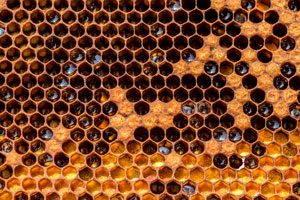Bee Nests and Beehives
Serving Las Vegas | Henderson | North Las Vegas
 Beehives are not technically the same as bee nests. “Beehive” refers to a man-made structure for bees, managed by beekeepers. For the sake of information, we’ll go over the basics of bee colonies–regardless of whether they’re hives or nests.
Beehives are not technically the same as bee nests. “Beehive” refers to a man-made structure for bees, managed by beekeepers. For the sake of information, we’ll go over the basics of bee colonies–regardless of whether they’re hives or nests.
How do beehives work?
Bees maintain a complex social order, and there are a lot of moving parts to a bee colony. Whether or not it’s a “natural” hive or a manmade beehive, honeycomb is the structure that bees build to live in, lay eggs, and store food. Here are the basic components of a beehive or nest:
- Entrance: Bees prefer a small entrance, so it can be easily guarded.
- Honeycomb: This is actually what the entire nest is made of. Bees make honeycomb by eating honey, and then using the wax they secrete to build the classic hexagonal shapes.
- Brood Comb: This is where the queen lays eggs, and where the larvae grow into workers, drones, and future queens.
- In manmade beehives, the brood comb is typically at the bottom of the hive.
Bees keep food in every corner of their nest, storing it against the winter famine.
Ready to Schedule your Free Bee Removal Estimate?
We’ll call you right back, in 30 minutes or less. Just fill in your info below!
How many bees live in a hive?
Wild bee nests will typically be much smaller than beehives, and may contain only 400 bees, depending on the species.
Because they’re managed by humans, beehives can contain up to 30,000 bees.
How do bees make honey?
This process is fascinating, but it’s not for the faint of heart!
- Forager bees collect nectar, and put it into one of two stomachs. If it’s destined to become honey, it goes in the honey stomach.
- Upon arriving back at the nest, the forager bee regurgitates the nectar into another bee’s mouth. That bee’s stomach adds digestive enzymes, and then the bee regurgitates it into another bee’s mouth.
- This process continues until the nectar is “done”.
- The regurgitated nectar is put into a honeycomb cell.
- Bees fan the pre-honey mixture, evaporating the water from the substance and thickening it.
- The cell is sealed, and the pre-honey is left to complete its transformation into honey.
What pests and insects feast on honeycomb?
There are a number of pests that can infest and attack beehives, including the small hive beetle, Varroa mites, and wax moths. These pests typically don’t cause any trouble for humans.
However, there are wildlife pests that can become an issue with honeycomb, including skunks, opossums, bears, and raccoons. If you have a bee colony removed from your property, we really recommend having the entire nest removed, to prevent wildlife issues.
Can bees live without a hive?
Technically yes, but only for a short time (about three days). Bees will leave the nest in spring to start new nests (this is called swarming), but it’s a temporary move.
Without a permanent nest, bees cannot reproduce or sustain their population, and a colony will die. If you have bees removed from your property, we do everything in our power to relocate the bees to a suitable nest or beehive. We believe in protecting bees!
Common Questions About Beehives in Las Vegas and Henderson NV
Extermination Services in Las Vegas NV, North Las Vegas and Henderson NV

